Cada día, somos bombardeados con información sobre la crisis ambiental, social y cultural en la industria de la moda. Pero, ¿realmente estamos tomando acción o simplemente esperando a que las marcas y gobiernos lo hagan por nosotros? No se trata solo de comprar menos o reciclar más, sino de convertirnos en agentes de cambio que exigen responsabilidad y transparencia. Para comprender mejor cómo podemos hacerlo, entrevistamos a tres expertos del sector: Cecilia Manzur, Diseñadora y Modelista de Vestuario y Asesora de Imagen, Chile, y Alicia Mares, Corresponsal de Negocios de Moda en México y Latinoamérica para Fashion Network y Alfonso Martínez Equihua, Director General de Industrias Marves y Co Fundador re.colecto.
A través de sus perspectivas, reiteramos estrategias clave que cada consumidor puede implementar para impulsar transformaciones reales en la industria.
Dejar de Esperar Información: El Poder del Conocimiento

Cecilia Manzur enfatiza que uno de los primeros pasos para generar cambios es dejar de esperar que la información nos llegue sola. Como consumidores, debemos buscar activamente datos sobre marcas, procesos de producción y sostenibilidad. Preguntar en tiendas sobre sus políticas de reciclaje o fabricación, no solo nos da herramientas para tomar mejores decisiones, sino que presiona a las empresas a ser más transparentes.
Desde su experiencia como asesora de imagen, Cecilia también destaca que enseñar a otros sobre consumo responsable, selección de prendas de calidad y exploración de opciones, como la ropa de segunda mano, puede marcar la diferencia. Como diseñadora, considera que el cambio también debe venir de la industria, diseñando colecciones con materiales sostenibles y procesos de producción más éticos.
Por otro lado, Alfonso nos dice que “el consumidor tiene mucho más poder y responsabilidad en la industria de la moda de lo qué cree. Cada compra manda un mensaje al mercado, y las grandes marcas están escuchando”.
Redes Sociales: ¿Herramienta de Cambio?
Alicia Mares nos recuerda que en la era digital, los consumidores tienen un poder sin precedentes. Antes, los movimientos sociales requerían marchas y protestas; hoy, “ya no es de boca en boca, es de publicación en publicación”, nos dice. Sin embargo, advierte que este poder debe usarse con responsabilidad. Un mal uso de la información puede desacreditar esfuerzos genuinos y desviar la atención de los verdaderos problemas.
De igual forma nos comenta que además de ser una herramienta de denuncia y presión, las redes sociales también funcionan como una fuente inagotable de información y conocimiento. Ahora, desde nuestras redes sociales, podemos cuestionar a las marcas, compartir información sobre eventos, iniciativas, y apoyar a proyectos sostenibles, lo que dirige al consumidor a hacer compras más conscientes. La clave está en filtrar la información, verificar fuentes y compartir contenido que realmente aporte valor a la conversación, lo que generará transformación.

Asimismo nos dice que la propagación de campañas, iniciativas, testimonios de consumidores, etc. ha demostrado ser un motor de cambio en la industria. Cuando una marca es señalada por prácticas poco éticas, la presión mediática puede obligarla a modificar sus procesos. Pero del mismo modo, cuando una empresa implementa políticas responsables, los consumidores pueden amplificar ese mensaje, generando una demanda por productos y servicios alineados con la sostenibilidad; “un simple clic puede hacer muchísima diferencia”, nos dice Alicia.
De igual forma, resalta la importancia de participar activamente, por ejemplo al prolongar la vida útil de nuestras prendas a través de la reparación, el reciclaje y la compra de ropa de segunda mano. Esto no solo reduce el impacto ambiental, sino que envía un mensaje claro a la industria sobre la creciente demanda de alternativas sostenibles. Al respecto, Alfonso nos explica que re.colecto proporciona una oportunidad de mucho menor impacto al desechar nuestras prendas y presenta la oportunidad de darles una segunda vida.
Transparencia: El Vínculo Perdido entre Consumidores, Gobiernos y Marcas

Tanto Cecilia como Alicia coinciden en que la falta de transparencia y comunicación de gobiernos y marcas obstaculiza el avance hacia una moda sostenible. Cecilia nos habla sobre la Ley REP (Ley de Responsabilidad Extendida del Productor) en Chile, la cual incentiva a las empresas a implementar prácticas más responsables, otorgándoles puntajes adicionales en licitaciones y promoviendo la recolección de residuos. Por otro lado, Alicia nos comenta sobre iniciativas como la feria “Original”, que apoya a los artesanos, y la prohibición de pruebas cosméticas en animales en México, avances importantes, pero que su escasa difusión hace que pasen desapercibidos.
De igual modo, Alfonso estipula que “en México, aún falta camino en regulaciones que incentiven una industria textil más sostenible. Nos dice que “se habla de la responsabilidad extendida del productor”, pero que “también es clave la corresponsabilidad del consumidor” y que “la solución no está solo en las marcas ni en los gobiernos: está en una mayor conciencia sobre cómo elegimos, usamos y desechamos nuestra ropa”.
Por otra parte nos comenta que al demandar transparencia para producir responsablemente y sobre el uso de materiales más durables, las marcas seguirán escuchando y habrá un impacto positivo de mayor grado.
Si los gobiernos y marcas fueran más abiertos y transparentes sobre sus proyectos, acciones y políticas, se generaría una mayor conciencia en los consumidores. La comunicación efectiva y transparente no solo permitiría que las personas tomaran mejores decisiones, sino que también alentaría a más empresas a sumarse a las prácticas sostenibles, comenta Alicia y Alfonso agrega que “si hubiera más información clara sobre regulaciones y prácticas responsables, tanto de gobiernos como de marcas, los consumidores podrían tomar mejores decisiones y nos comenta que “la transparencia genera confianza y compromiso”.
La Petición Más Urgente para Marcas y Gobiernos
Si pudieran pedir una sola acción inmediata, Cecilia, Alicia y Alfonso tienen solicitudes claras. Cecilia señala la necesidad de regular la importación de textiles provenientes del norte, ya que, como bien se sabe, toneladas de ropa terminan en vertederos en el desierto sin ningún control. Implementar normativas más estrictas en este sentido demostraría un verdadero compromiso gubernamental con la sostenibilidad.
Alicia, en cambio, enfatiza que la clave está en la transparencia. Si las marcas y gobiernos no comunican lo que están haciendo (o lo que no están haciendo), los consumidores quedan en la oscuridad, sin herramientas para exigir mejoras reales.
Para Alfonso, el impulso hacia una forma de trabajar en donde productores y consumidores participen de forma activa en la economía circular es esencial, y destaca que “no basta con producir mejor, también debemos consumir mejor y reducir el desperdicio”.
No Esperes el Cambio, Sé el Cambio
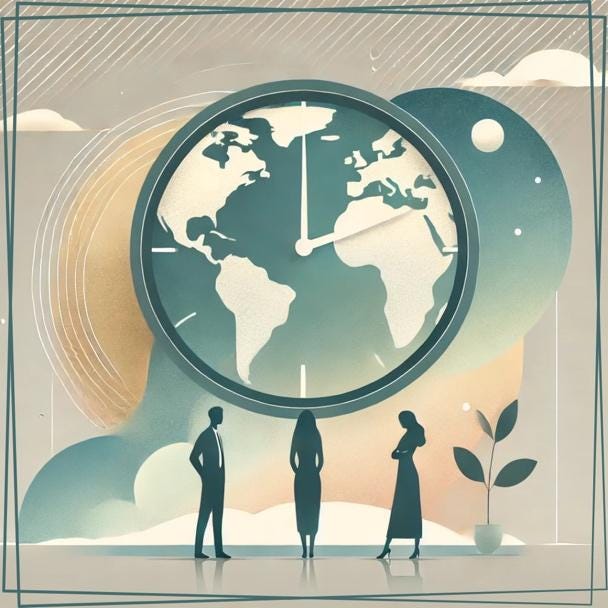
El futuro de la moda sostenible no depende exclusivamente de las marcas y gobiernos, sino también de la determinación individual de los consumidores. Desde buscar información activamente hasta exigir transparencia y apoyar iniciativas sostenibles, cada decisión cuenta. Dejar de esperar y empezar a actuar es el primer paso para transformar la industria textil y de la moda en una más ética y responsable y las redes sociales, cuando se usan de manera estratégica y fundamentada, pueden ser una de nuestras mejores aliadas en este camino; no sólo para denunciar y presionar, sino también para educarnos, compartir información valiosa y construir una comunidad consciente y comprometida con el cambio.
La pregunta es: ¿te quedas esperando o tomas acción?
 .
.
Alicia Mares, Corresponsal
de Negocios y Moda en México
y Latinoamérica para
Fashion Network
Cecilia Manzur, Diseñadora
, Modelista de Vestuario y
Asesora de Imagen, Chil
Alfonso Martínez Equihua
Director General de Industrias
Marves y Co Fundador de re.colecto
Por: Silvia Jiménez de la Mora, Consultora en Imagen y Guardarropa Sostenible, AICI CIC,
Directora del Comité de Sustentabilidad para AICI Global.
English
From Passivity to Action: How Can Consumers Demand More Responsible Fashion?
By: Silvia Jiménez de la Mora, Image and Sustainable Wardrobe Consultant, AICI CIC,
Director of the Sustainability Committee for AICI Global.
Every day, we are bombarded with information about the environmental, social, and cultural crisis in the fashion industry. But are we really taking action or simply waiting for brands and governments to do it for us? It’s not just about buying less or recycling more, but about becoming agents of change who demand accountability and transparency. To better understand how we can do this, we interviewed three industry experts: Cecilia Manzur, Costume Designer, Modeler, and Image Consultant, Chile; Alicia Mares, Fashion Business Correspondent in Mexico and Latin America for Fashion Network; and Alfonso Martínez Equihua, CEO of Industrias Marves and Co-Founder of re.colecto.
Through their perspectives, we reiterate key strategies that every consumer can implement to drive real transformations in the industry.
Stop Waiting for Information: The Power of Knowledge
Cecilia Manzur emphasizes that one of the first steps to generating change is to stop waiting for information to come to us. As consumers, we must actively seek out data about brands, production processes, and sustainability. Asking stores about their recycling or manufacturing policies not only gives us tools to make better decisions, but also pressures companies to be more transparent.
Based on her experience as an image consultant, Cecilia also highlights that teaching others about responsible consumption, selecting quality garments, and exploring options, such as secondhand clothing, can make a difference. As a designer, she believes that change must also come from the industry, designing collections with sustainable materials and more ethical production processes.
On the other hand, Alfonso tells us that “consumers have much more power and responsibility in the fashion industry than they think. Every purchase sends a message to the market, and big brands are listening.”
Social Media: A Tool for Change?
Alicia Mares reminds us that in the digital age, consumers have unprecedented power. Previously, social movements required marches and protests; today, “it’s no longer word of mouth, it’s publication after publication,” she tells us. However, she warns that this power must be used responsibly. Misuse of information can discredit genuine efforts and divert attention from the real problems.
She also tells us that in addition to being a tool for denunciation and pressure, social media also functions as an inexhaustible source of information and knowledge. Now, through our social networks, we can question brands, share information about events and initiatives, and support sustainable projects, which leads consumers to make more conscious purchases. The key is to filter information, verify sources, and share content that truly adds value to the conversation, which will generate transformation.
He also tells us that the spread of campaigns, initiatives, consumer testimonials, etc. has proven to be a driver of change in the industry. When a brand is called out for unethical practices, media pressure can force it to modify its processes. But similarly, when a company implements responsible policies, consumers can amplify that message, generating demand for products and services aligned with sustainability; “a simple click can make a huge difference,” Alicia tells us.
Similarly, she highlights the importance of actively participating, for example by extending the lifespan of our clothes through repairing, recycling, and buying secondhand clothing. This not only reduces the environmental impact but also sends a clear message to the industry about the growing demand for sustainable alternatives. In this regard, Alfonso explains that re.colecto provides a much lower-impact opportunity to discard our clothes and presents the opportunity to give them a second life.
Transparency: The Missing Link between Consumers, Governments, and Brands
Both Cecilia and Alicia agree that the lack of transparency and communication from governments and brands hinders progress toward sustainable fashion. Cecilia tells us about Chile’s Extended Producer Responsibility Law (REP), which incentivizes companies to implement more responsible practices, giving them additional points in bidding processes and promoting waste collection. Alicia also shares about initiatives such as the “Original” fair, which supports artisans, and Mexico’s ban on animal testing for cosmetics. These are important advances, but their limited publicity means they go unnoticed.
Similarly, Alfonso stipulates that “in Mexico, there is still a long way to go in regulations that encourage a more sustainable textile industry. He tells us that “there is talk of extended producer responsibility,” but that “consumer co-responsibility is also key” and that “the solution lies not only with brands or governments: it lies in greater awareness about how we choose, use, and dispose of our clothing.”
Furthermore, he tells us that by demanding transparency in responsible production and the use of more durable materials, brands will continue to listen and there will be a greater positive impact.
If governments and brands were more open and transparent about their projects, actions, and policies, greater awareness would be generated among consumers. Effective and transparent communication would not only allow people to make better decisions but would also encourage more companies to adopt sustainable practices, Alicia comments. Alfonso adds that “if there were more clear information about regulations and responsible practices, from both governments and brands, consumers could make better decisions.” He tells us that “transparency generates trust and commitment.”
The Most Urgent Request for Brands and Governments
If they could ask for a single immediate action, Cecilia, Alicia, and Alfonso have clear requests. Cecilia points out the need to regulate the import of textiles from the north, since, as is well known, tons of clothing end up in desert landfills without any control. Implementing stricter regulations in this regard would demonstrate a true government commitment to sustainability.
Alicia, on the other hand, emphasizes that the key is transparency. If brands and governments don’t communicate what they are doing (or what they aren’t doing), consumers are left in the dark, without the tools to demand real improvements.
For Alfonso, the push toward a way of working where producers and consumers actively participate in the circular economy is essential, and he emphasizes that “it’s not enough to produce better; we must also consume better and reduce waste.”
Don’t Wait for Change, Be the Change
The future of sustainable fashion depends not only on brands and governments, but also on the individual determination of consumers. From actively seeking information to demanding transparency and supporting sustainable initiatives, every decision counts. Stopping waiting and starting to act is the first step toward transforming the textile and fashion industry into a more ethical and responsible one. Social media, when used strategically and thoughtfully, can be one of our greatest allies on this path; not only to expose and pressure, but also to educate ourselves, share valuable information, and build an aware community committed to change.
The question is: do you wait or do you take action?
Greenhushing a divatiparban: az új negatív fenntarthatósági trend?
A fenntartható divat és a környezettudatos vásárlás egyre népszerűbb témákká váltak az elmúlt években, a hétköznapi fogyasztók is jobban figyelemmel kísérik és érzékenyebben reagálnak divatmárkák lépéseire, döntéseire. Könnyen lehet, hogy már te is hallottál a greenwashing jelenségről, de mi a helyzet a csendesebb „testvérével”, a greenhushinggal, az úgynevezett zöld elhallgatással? Utánajártunk, hogy mit jelent pontosan ez a fogalom és hogyan érinti a divatipart, a gyártókat és a fogyasztókat.

Mi az a greenhushing?
A greenhushing olyan gyakorlat, amikor cégek, márkák szándékosan elhallgatják fenntarthatósági erőfeszítéseiket és céljaikat, még akkor is, ha azok jó szándékúak és előrevezetőek. Ennek egyik fő oka a “greenwashing” vádjától vagy a nyílvános kritikáktól való félelem. Ezen túlmenően sokan tartanak attól is, hogy ha nyilvánosságra hozzák fenntarthatósági céljaikat, és azokat nem sikerül teljesíteniük, akkor hitelességük csorbulhat. Ez a jelenség különösen a kisebb vállalkozások körében figyelhető meg, amelyek számára a fenntarthatósági tanúsítványok megszerzése költséges lehet, ezért inkább a háttérben végzik fenntartható tevékenységeiket.
A greenhushing jelenség azonban több szempontból is problémás. Egyrészt gátolja az iparág átláthatóságát, hiszen a márkák nem osztják meg egymással és a nyilvánossággal a fenntarthatósági gyakorlatokat és innovációkat, amelyek másokat is inspirálhatnának, edukálhatnának, változásra sarkallhatnának. Másrészt a fogyasztók egyre inkább igénylik a vállalatok fenntarthatósági tevékenységeiről szóló információkat, és a kommunikáció hiánya pedig bizalmatlanságot szülhet. Ezen kívül, ha nem vállalják fel nyilvánosan a fenntarthatósági céljaikat, akkor elmarad a számonkérhetőség is, ami szintén nem előrevezető a környezeti változások elősegítésében.
A greenhushing tehát, bár elsőre ártalmatlannak tűnhet, hosszú távon akadályozza a fenntarthatóságra irányuló globális erőfeszítéseket, és éppen ezért akár ugyanolyan káros lehet, mint a greenwashing.
Mi a különbség?
A legfőbb különbség a greenwashing és a greenhushing között az, hogy mit osztanak meg (vagy mit nem) a fogyasztókkal, és ezt milyen szándékkal teszik.
A greenwashing során a vállalatok túlzó állításokkal és megtévesztő marketinggel próbálják fenntarthatónak feltüntetni magukat, míg a greenhushing esetében szinte éppen az ellenkezője történik: elhallgatják vagy minimalizálják környezettudatos tevékenységeiket és a környezetvédelmi gyakorlataikat. Az eredmény mindkét esetben az, hogy a fogyasztók nem kapnak teljes képet, így átláthatatlanná válnak a márkák valódi tevékenységei és nem tudhatjuk meg, hogy mi zajlik pontosan a háttérben.

Miért választják a márkák a greenhushingot?
Bár a greenhushing kedvezőtlen hatással van a divatiparra, nem szabad hibáztatni az etikus kisvállalkozásokat, ha óvatosan bánnak fenntarthatósági céljaik nyilvánosságra hozatalával. Gondoljunk csak bele, hogy milyen kihívásokkal találkozik egy kis, etikus márka.
Nem könnyű fenntarthatóan működni kis márkaként, akiknek nem csak az elindulás nehéz, hanem az is, hogy tartósan a piacon tudjanak maradni, így az etikus divatmárkák különösen nehéz helyzetben találhatják magukat. Elég csak abba belegondolni, hogy a fenntartható ruházat előállítása és etikus marketingje sokkal magasabb árakat követel, -miközben a haszonkulcs alacsonyabb-, mint a fast fashion óriások esetében. A fenntartható alapanyag, a lokális gyártás, a kézművesség mind-mind hozzájárul ahhoz, hogy a végén miért lesz a termék ára sokkal magasabb, mint a tömeggyártott daraboknak. A slow fashion minőséget és értéket képvisel.
A kisvállalkozásoknak legtöbbször nincs elég erőforrásuk, hogy profi kommunikációs csapatokat vagy jogi szakértelmet alkalmazzanak, így inkább nem osztanak meg információkat, hogy elkerüljék a greenwashing vádját.
Továbbá, ebben a túlzottan érzékeny világban, sok kisebb, de akár nagyobb cég is fél attól, hogy ha túl sokat oszt meg fenntarthatósági terveiről és nem tudják maradéktalanul teljesíteni azokat, akkor kritikát kapnak. Ez kis márkaként akár vevő és publikumvesztést is jelenthet, amit nem engedhet meg magának sem a kezdeti, sem a későbbi időszakokban. Így az ilyen helyzetekben legtöbben inkább a csendet választják.

Te vagy én tudunk tenni valamit a greenhushing csökkentésében? Igen!
- Támogassuk az átláthatóságot: Keressünk olyan márkákat, amelyek őszintén beszélnek termékeikről és gyártási folyamataikról.
- Legyünk megértőek: A kisvállalkozások gyakran szűkös erőforrásokkal dolgoznak, de sokuk valóban igyekszik fenntarthatóbbá tenni az ipart.
- Tudatos vásárlás: Keressük az etikus és fenntartható márkákat, valamint tájékozódjunk vásárlás előtt.
Bár a greenhushing nem olyan feltűnő, mint a greenwashing, mégis komoly kihívást jelent a divatipar átláthatósága szempontjából. Az ipar fenntartható átalakulásához nemcsak a márkák aktív részvételére van szükség, hanem a fogyasztók tudatosságára is, hiszen csak így érhető el, hogy a divat valóban fenntarthatóbb és átláthatóbb legyen. De vajon ugyanolyan veszélyes a greenhushing, mint a greenwashing? Jó kérdés, és talán nincs is rá egyértelmű válasz.
Az viszont biztos, hogy azok a cégek és márkák, amelyek a zöld elhallgatást választják, egyúttal azt is eldöntik, hogy nem osztják meg jó példáikat, innovatív és eredeti gondolataikat – pedig ezek másokat is inspirálhatnának a fenntarthatóbb működésre. Így jogosan tehetjük fel a kérdést magunkban, hogyha pozitív példák rejtve maradnak, hogyan várhatjuk el, hogy a fenntartható fejlődés valóban széles körben elterjedjen és vajon hogyan alakulhat át a divatipar egy olyan ágazattá, amely nemcsak a környezettudatosságot hirdeti, hanem annak hiteles képviselőjévé is válik? Talán ez lehet az elkövetkezendő időkben a divatipar egyik meghatározó kérdése, amelyre a választ a gyártónak és fogyasztónak együtt kell keresnie.
Írta/ fordította: Kovács Enikő
Források:
Greenhushing in Fashion: It’s Bad… But We Kind of Get it | Sustainable Fashion Blog | Project Cece
MN6 Energiaügynökség – Greenhushing – az új negatív fenntarthatósági trend
A greenhushing ma már legalább akkora gond, mint a greenwashing – Portfolio.hu
Mi az a greenhushing és miért olyan népszerű a cégek körében?
Képek forrása: Unplash.
English
Greenhushing in the fashion industry: the new negative sustainability trend?
Written/translated by: Enikő Kovács
Sustainable fashion and eco-conscious shopping have become increasingly popular topics in recent years, with everyday consumers paying closer attention and reacting more sensitively to the actions and decisions of fashion brands. You may have heard of the phenomenon of greenwashing, but what about its quieter “brother”, greenhushing? We looked into what exactly this concept means and how it affects the fashion industry, manufacturers and consumers.
What is greenhushing?
Greenhushing is the practice of companies and brands deliberately hiding their sustainability efforts and goals, even if they are well-intentioned and progressive. One of the main reasons for this is the fear of being accused of “greenwashing” or being publicly criticized. In addition, many people fear that if they make their sustainability goals public and fail to meet them, their credibility may be damaged. This phenomenon is especially observed among smaller businesses, for which obtaining sustainability certificates can be expensive, and therefore they prefer to carry out their sustainable activities in the background.
However, the greenhushing phenomenon is problematic in several ways. On the one hand, it hinders transparency in the industry, as brands do not share with each other and with the public the sustainability practices and innovations that could inspire, educate and stimulate change. On the other hand, consumers are increasingly demanding information about companies’ sustainability activities, and a lack of communication can lead to distrust. In addition, if they do not publicly commit to their sustainability goals, there is a lack of accountability, which is also not conducive to promoting environmental change.
So, while greenhushing may seem harmless at first glance, it hinders global efforts towards sustainability in the long run and can therefore be just as harmful as greenwashing.
What is the difference?
The main difference between greenwashing and greenhushing is what is shared (or not shared) with consumers, and with what intention.
In greenwashing, companies try to portray themselves as sustainable through exaggerated claims and misleading marketing, while in greenhushing, almost the opposite happens: they conceal or minimize their environmentally conscious activities and practices. The result in both cases is that consumers do not get the full picture, making the real activities of brands opaque and preventing us from knowing exactly what is going on behind the scenes.
Why do brands choose greenhushing?
While greenhushing has a negative impact on the fashion industry, we can’t blame ethical small businesses for being cautious about publicizing their sustainability goals. Just think about the challenges a small, ethical brand faces.
It’s not easy to operate sustainably as a small brand, which not only has a hard time getting started, but also has a hard time staying in the market, so ethical fashion brands can find themselves in a particularly difficult position. Just think about the fact that the production and ethical marketing of sustainable clothing requires much higher prices – while the profit margin is lower – than in the case of fast fashion giants. Sustainable raw materials, local production, craftsmanship all contribute to why the price of the product is much higher in the end than mass-produced pieces. Slow fashion represents quality and value.
Small businesses often lack the resources to hire professional communications teams or legal expertise, so they prefer not to share information to avoid accusations of greenwashing.
Furthermore, in this hyper-sensitive world, many smaller and even larger companies are afraid that if they share too much about their sustainability plans and fail to fully implement them, they will be criticized. As a small brand, this can even mean losing customers and audiences, which you cannot afford either in the initial or later periods. So in such situations, most people prefer to remain silent.
Can you or I do something to reduce greenhushing? Yes!
Support transparency: Look for brands that are honest about their products and production processes.
Be understanding: Small businesses often work with limited resources, but many of them are genuinely trying to make the industry more sustainable.
Shop consciously: Look for ethical and sustainable brands and do your research before you buy.
Although greenhushing is not as visible as greenwashing, it still poses a serious challenge to transparency in the fashion industry. A sustainable transformation of the industry requires not only the active participation of brands, but also consumer awareness, as this is the only way to truly make fashion more sustainable and transparent. But is greenhushing as dangerous as greenwashing? It’s a good question, and perhaps there’s no clear answer.
What is certain, however, is that companies and brands that choose to remain green are also choosing not to share their good examples, innovative and original ideas – which could inspire others to operate more sustainably. Thus, we can rightly ask ourselves the question: if positive examples remain hidden, how can we expect sustainable development to truly spread widely and how can the fashion industry transform into a sector that not only promotes environmental awareness, but also becomes a credible representative of it? Perhaps this could be one of the defining questions of the fashion industry in the coming times, the answer to which must be sought by the manufacturer and the consumer together.
Sources:
Greenhushing in Fashion: It’s Bad… But We Kind of Get it | Sustainable Fashion Blog | Project Cece
MN6 Energiaügynökség – Greenhushing – az új negatív fenntarthatósági trend
A greenhushing ma már legalább akkora gond, mint a greenwashing – Portfolio.hu
Mi az a greenhushing és miért olyan népszerű a cégek körében?
Off Paper: The Hidden Cost of Home-based Workers
By: Aastha Jain , member of Fashion Revolution India
 No Policies, No Records—42 million home-based workers remain systematically invisible, with approximately 19% engaged in apparel production. As a policy researcher with the Fashion Transparency Index Working Group between September 2024 and December 2024, I met several women stitching buttons and embroidering and overturning socks in Delhi’s dense colonies, revealing the mechanisms through which capitalist structures perpetuate exploitation, transforming homes into sites of economic negotiation.
No Policies, No Records—42 million home-based workers remain systematically invisible, with approximately 19% engaged in apparel production. As a policy researcher with the Fashion Transparency Index Working Group between September 2024 and December 2024, I met several women stitching buttons and embroidering and overturning socks in Delhi’s dense colonies, revealing the mechanisms through which capitalist structures perpetuate exploitation, transforming homes into sites of economic negotiation.
The informal sector has three archetypes: contractors, piece-rate workers, and self-employed workers. Their labour encompasses completing semi-finished apparel and accessories like bags, shoes, cushion covers, and bangles, assembling bindi packets, attaching buttons, applying trims, packaging, labeling, embroidery, and crochet.
 Fixed contractors connected to factories function as intermediaries who distribute work daily or weekly in different neighborhoods. Factories dictate compensation for the contractors. The contractors extract a 40-50% margin before redistributing wages. Piece rates demonstrate huge variability, fluctuating based on geographical location, distance from factories, labour demand, and skills scarcity—ranging from INR 1 ($0.012) to INR 70 ($0.83) per piece. The COVID-19 pandemic exacerbated existing vulnerabilities. Unlike other sectors experiencing recovery post-pandemic, this trade witnessed a wage decline. Contractors, who also tend to be migrant workers, often run away with the due amount. Those who stay nearby or in the same neighborhood as workers show cooperation and timely payment.
Fixed contractors connected to factories function as intermediaries who distribute work daily or weekly in different neighborhoods. Factories dictate compensation for the contractors. The contractors extract a 40-50% margin before redistributing wages. Piece rates demonstrate huge variability, fluctuating based on geographical location, distance from factories, labour demand, and skills scarcity—ranging from INR 1 ($0.012) to INR 70 ($0.83) per piece. The COVID-19 pandemic exacerbated existing vulnerabilities. Unlike other sectors experiencing recovery post-pandemic, this trade witnessed a wage decline. Contractors, who also tend to be migrant workers, often run away with the due amount. Those who stay nearby or in the same neighborhood as workers show cooperation and timely payment.
A shared space for home and work exposes profound gender-based contradictions. Women, responsible for domestic labour, are compelled to negotiate complex frameworks—first fulfilling family responsibilities, then pursuing work in the remaining time. Women decide whether they can accommodate more labour or not as per their domestic schedule. Many women are not allowed to move outside, rendering home-based work as a survival strategy. Work remains fundamentally precarious: no monthly guarantees, with labour oscillating between hectic periods and prolonged intervals of scarcity. The irregularity breeds systemic mistrust and hopelessness, compelling some to abandon this labour mode while others persist as a final economic recourse.
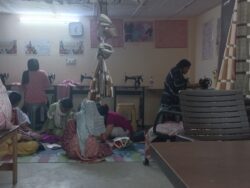 To meet their basic needs, workers try to maximise work, generating low piece-rate wages. Such compensation structures incentivize maximum labour extraction. Families, including children who spend substantial amounts of time with mothers, become integrated into production processes. The fundamental contradiction emerges: how can corporations proclaim freedom from forced or child labour when entire communities are economically coerced into such labour arrangements?
To meet their basic needs, workers try to maximise work, generating low piece-rate wages. Such compensation structures incentivize maximum labour extraction. Families, including children who spend substantial amounts of time with mothers, become integrated into production processes. The fundamental contradiction emerges: how can corporations proclaim freedom from forced or child labour when entire communities are economically coerced into such labour arrangements?
In Delhi, workers inhabit densely populated neighborhoods characterized by open sewage systems, intermittent electricity supply, water scarcity, and inadequate ventilation. Typical living rooms(a 10 x 10 feet space)egregiously contradict International Labour Organization (ILO) conventions mandating workspace requirements. Workers absorb additional economic burdens, including electricity costs, healthcare expenses, and workspace rental, which remain strategically unaccounted for in supply chain calculations.
“Bindi sticking impacts eyesight, back pain, and exposure to chemicals severely. Another such hazard is from clothes made with chemical dyes. During extreme heat in summer, dyes stick to hands causing skin infections. No provision of safety gears, social security schemes, healthcare provisions worsen the worker’s conditions.” – Subadhra Pandey, Representative SEWA in Delhi
 Unionization of informal workers confronts multifaceted obstacles: absence of direct employer contact, lack of governmental protective mechanisms, and the invisibility of home-based labour. Brand identification by workers and the union is impossible within this fragmented production ecosystem. Merely 0.25% of workers comprehend their position within broader supply chains, mentions Subadhra. The proliferation of counterfeit products further obscures potential accountability mechanisms.
Unionization of informal workers confronts multifaceted obstacles: absence of direct employer contact, lack of governmental protective mechanisms, and the invisibility of home-based labour. Brand identification by workers and the union is impossible within this fragmented production ecosystem. Merely 0.25% of workers comprehend their position within broader supply chains, mentions Subadhra. The proliferation of counterfeit products further obscures potential accountability mechanisms.
SEWA is a union of 2.9 million informal workers. SEWA in Delhi serves 70,000 workers out of which 7,000 work in the garment industry as home-based workers. Along with other South Asian organisations, the union has developed a transparency tool called Wage Card to document monthly work and negotiate for fair wages. This tool records transactional details, work performed, payments due, and brand associations.
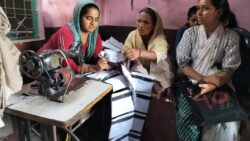 The fundamental struggle demands systemic recognition. Unions articulate comprehensive demands: joint employer responsibility, profit redistribution, social security provisions, regular work, minimum wage guarantees, and most importantly ratification of international labour conventions- C177.
The fundamental struggle demands systemic recognition. Unions articulate comprehensive demands: joint employer responsibility, profit redistribution, social security provisions, regular work, minimum wage guarantees, and most importantly ratification of international labour conventions- C177.
The invisibility of home-based workers reinforces profound epistemic violence—where labour is essential yet systematically marginalized. Most workers do not even acknowledge themselves as workers but as homemakers, wives, or mothers. Their work remains unacknowledged by governments, employers, and manufacturers alike. The hidden costs—including electricity, tools, healthcare, family labor, and unpaid wages—create a perception of cheap production, enabling brands to increase profits by transferring economic burdens to the working class of producing nations.
–
The article is written by Aastha Jain, a visual designer and researcher. She is also a member of Fashion Revolution India. The insights are based on discussions with Subadhra Pandey, Representative SEWA in Delhi, and home-based workers from Delhi. For contact, reach at: aasthajn29@gmail.com
On Paper: Worsening Conditions of Labour in India’s Garment Sector
By: Aastha Jain , member of Fashion Revolution India
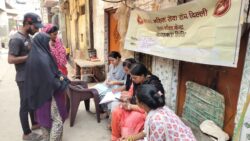
The conditions of workers in producing nations like India reveal a stark contradiction: despite increasing international legislative protections, workers’ lived experiences continue to deteriorate. The acts of intensifying production and alienation of labour have left the workers isolated with stagnant minimum wages and growing monopolization of brands and suppliers. During my time as a policy researcher with the Fashion Transparency Index Working Group between September 2024 and December 2024, I discussed with the union leaders and researchers, the conditions of the garment workers on the shop floor, and the conditions of piece-rate home-based workers in India.
Rukmini VP, President of Garment Labour Union(GLU) highlights that amongst 72 sectors across industries in India, only 4 sectors namely Garment, Leather, Spinning, and Textile have the lowest wages; INR 8,000 ($95) – INR 12,000 ($143) per month (p/m). As per the national law, minimum wages have to be revised every 3-5 years, yet it has stagnated for over a decade in many states. Even if it gets revised its implementation is rare, often retaliated by the factory owners with court cases.
Labour requiring an average of 9 to 11 hours per day (which contradicts Indian Labour Law that limits to 48 hours a week), and paying less than $100 p/m, can increase up to 14 to 16 hours per day during peak seasons.“Workers are allowed a maximum of 30-minute break, and even this is contingent on meeting punishing production targets of 150-200 garment pieces per hour,” says Rukmini VP. Rampant harassment, caste-based discrimination, poor healthcare, and childcare facilities, are further deteriorating the physical, social, and mental conditions of a worker.
“Workers are allowed a maximum of 30-minute break, and even this is contingent on meeting punishing production targets of 150-200 garment pieces per hour,” says Rukmini VP.
The gendered nature of the workforce amplifies these economic challenges. A predominantly female workforce (around 90%) migrates across states to manufacturing districts, being first-generation industrial workers. These migrant workers face heightened risks of harassment, possess weak negotiation power, and experience job insecurity. Underage girls between 14 and 15 years enter factories using falsified age certificates.

In addition to this exploitation which leaves individual workers vulnerable, organising resistance is also made difficult. According to interviewed union representatives, In India, less than 4% of the working class in the garment industry are part of unions. Additionally, they state that the brands, and factories employ extreme forms of tactics to suppress workers from organizing, including targeting the workers, surveillance, economic intimidation, creating yellow trade unions, stopping purchase orders (stop sourcing from that vendor), terminating employment, and threatening organizers, amongst others.
Paradoxically, increasing compliance has created new forms of exploitation. The documentation process has become so complex that specialized firms now solely manage supplier paperwork. Small manufacturers unable to navigate this bureaucratic labyrinth are being systematically eliminated, establishing a monopoly on large manufacturers. The legitimacy of submitted documentation also remains highly non-reflective of the conditions. It remains unreliable due to sole commitment to paper as a tool for auditing. There are no third-party audits or unplanned visits to verify the information shared in the submitted documents. Factory visits are meticulously planned, with workers threatened to maintain silence. The auditors do not engage with the unions who could bear testimony to the true working conditions.

Brands have transferred their responsibility and accountability of ensuring decent working conditions to the suppliers without transferring actual ownership or profits: a sublime act of class manipulation. This paper trail becomes a shield, protecting brands from accountability while maintaining the illusion of ethical production. Workers remain trapped in a system where documentation matters more than real working conditions.
Paper emerges as an instrument of oppression, simultaneously serving as a survival mechanism for the oppressed. Entrenched in their accumulated wealth, the ruling class wields economic instruments, crafting an illusion of autonomy while sharpening the blades of systemic exploitation. Combating global capitalism’s inherent transnational nature, the struggle demands international solidarity. Amidst poor implementation of local state mechanisms, trade unions increasingly rely on global support to negotiate effectively. Their core demands remain fundamental: joint employer responsibility, living wages, union recognition, regular unannounced inspections, and dignified working conditions.
——
The article is written by Aastha Jain, a visual designer and researcher. She is also a member of Fashion Revolution India. The insights are based on discussions with Rukmini VP, Garment Labour Union, Nandita Shivkumar, labour Rights Researcher, and Thivya Rakini, Tamil Nadu Textile Commons Unions. For contact, reach at: aasthajn29@gmail.com
By: So Young Park – Country Coordinator at Fashion Revolution South Korea
We all have old T-shirts with stretched or frayed necklines from countless days of wear and tear. I have clothes tucked away in the back of my wardrobe that I occasionally pull out to reminisce. Volunteering with Fashion Revolution for the past three years has taught me that fashion activism isn’t just about buying clothes with a “sustainable” label. Instead, it’s about digging through your wardrobe, pulling out old clothes, and finding ways to breathe new life into them. I waited until a hole the size of my thumb appeared in a favorite shirt, figured out how to sew it up, covered the hole with thread in my favorite color, and now enjoy the satisfaction of wearing it every time.
My journey into sustainable fashion began in 2020 in a small Batik studio in Jakarta, where I met passionate textile enthusiasts. There, I learned about the craft, history, rituals, and the deep connections between textiles, communities, and respect for nature. This experience profoundly shifted my perspective on life, extending far beyond textiles and fashion. I came to understand that clothing is more than just fabric on our bodies; it represents an ongoing dialogue with the people who make it. It is not something disposable to be taken and thrown away.

In 2021, while traveling through the beautiful landscapes of West Java, I witnessed a polluted river filled with industrial waste and a mountain littered with discarded clothes. It was a shocking sight. My nine-year-old son looked at me and said, “Mum, we have to do something for the planet.” His words stayed with me, and I began searching for ways to make a difference. Together with the dedicated members of Fashion Revolution South Korea, I’ve been volunteering to create digital campaigns that raise awareness about the complex fashion supply chain and its social and environmental impacts. These efforts include an exhibition called ‘Sa-o-ot (Love Clothes Last)’, which highlights the stories of people who have cherished their clothes for years, and translating and distributing the Fashion Transparency Index.
My nine-year-old son looked at me and said, “Mum, we have to do something for the planet.” His words stayed with me, and I began searching for ways to make a difference.

Through translation projects, I’ve met an incredible range of people—fashion designers, students, beauty industry researchers, educational planners, ESG consultants, and others—who have all said that participating in translation and campaign efforts raised their awareness. They expressed that the Fashion Transparency Index helped them understand industry changes and identify areas in need of improvement.
Year after year, the data in the report highlights key issues, revealing both progress and persistent challenges. The fashion industry’s impact varies profoundly across countries, often with devastating consequences. As detailed in the report, fashion can mean vastly different things depending on where you are: from glamorous runway shows to disposable trends that exploit vulnerable communities. In some countries, fashion is tied to women’s rights and freedoms. In others, it’s synonymous with sacrificing children’s education, clean water, and safe working conditions in favor of profits. Each country faces its unique challenges and issues to address within the fashion industry. South Korea, as one of the leading countries in the fashion industry, is no exception to these challenges including the struggles faced by small and medium-sized enterprises (SMEs) due to the weakening of the domestic production base. 
Despite these challenges, there is a universal set of values and directions we must pursue. We must recognize that these issues are not merely obstacles to overcome but opportunities to serve as turning points toward a sustainable future. On Volunteer Day, we honor the countless individuals who dedicate their time and effort to these principles. May their contributions fuel the growth of a just and green transition, paving the way for a more sustainable and equitable future.
By: Claudia Castanheira – Communications Manager at Fashion Revolution Brasil

After two weeks of complex negotiations and over a day of delays, COP29 concluded with the resignation of the poorest and most vulnerable countries, forced to accept a climate finance deal far below the $1 trillion annually demanded by 2035. The final agreement settled on $300 billion per year for climate financing until 2035, the result of over 30 hours of tense talks and setbacks.
Countries in the Global North, including the European Union delegation, the United States, and Canada, who advocated for less ambitious targets, were widely criticized by international observers and NGOs. The European bloc was even awarded the “Fossil of the Day” on November 20, a symbolic prize given by the Climate Action Network (CAN) to those seen as blocking progress during climate talks.
It’s important to highlight that without adequate financial resources, it will be impossible for countries — particularly those in the Global South — to implement climate actions for adaptation, mitigation, and a just energy transition. This lack of funding also puts the Paris Agreement’s goal of limiting global warming to 1.5°C at risk.
Another notable point was the lack of clear commitments to energy transition — including the phase-out of fossil fuels, a central theme of COP28 in Dubai. This objective, removed from the final document in 2023, was not explicitly reinstated in the agreement signed on Saturday, marking a victory for oil and gas-producing countries.
In a geopolitical context marked by wars and crises, achieving significant progress was expected to be a challenging task. However, the general feeling is that this COP resulted in few, if any, meaningful achievements, increasing distrust in the multilateral process to address the climate crisis.
Fashion at COP29
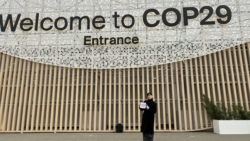
Fashion Revolution Brazil took part in COP29, engaging in discussions with civil society and other stakeholders to highlight the crucial role of fashion and textiles in addressing the climate crisis.
While formal negotiations left much to be desired, we came out stronger: Building new connections and forging global partnerships, which are essential for driving transformation in the industry.
As a civil movement, being part of these spaces is absolutely necessary. Even in the face of roadblocks and insufficient decisions, we reaffirmed our commitment to pursue a more transparent, fairer, and more sustainable fashion industry.
As members of the Brazilian delegation, we put forward clear demands:
For brands:
- Be transparent about how and where clothes are made, how many pieces are produced, and the social and environmental impacts of their production.
- Set ambitious targets for decarbonization and degrowth, and be clear about how these goals will be achieved.
- Publicly share updates on progress and concrete actions to meet these targets.
For policymakers:
- Develop policies to support Brazil and other garment-producing countries facing climate crises and vulnerabilities.
- Prioritize efforts to cut greenhouse gas emissions in the global fashion industry.
- Ensure small suppliers and family farmers have access to financial resources to build resilience against climate change.
At the event, we presented key reports, including What Fuels Fashion, a climate-focused analysis of the Global Fashion Transparency Index, and the latest edition of the Fashion Transparency Index Brazil, which reviews six years of progress and challenges in the industry.
COP30: What is next?
 Looking ahead, our goal is to mobilize the world’s largest civil movement for fashion to come together at COP30 in Belém, Brazil. This will be a landmark event: Brazil is the world’s top exporter of cotton, yet it faces major challenges like carbon emissions from deforestation and a dependency on fossil fuels.
Looking ahead, our goal is to mobilize the world’s largest civil movement for fashion to come together at COP30 in Belém, Brazil. This will be a landmark event: Brazil is the world’s top exporter of cotton, yet it faces major challenges like carbon emissions from deforestation and a dependency on fossil fuels.
The takeaway from COP29 is clear: COP30 must tackle the issues that remain unresolved. We’ll be there in the Amazon rainforest, demanding an end to fossil-fueled fashion and advocating for the rights of those most affected by the climate crisis, often the women who make our clothes.
The fashion climate agenda is just getting started!
Standing together with #FashionforClimate
What can you (citizens) do?
HEY BIG FASHION BRANDS,
START FINANCING YOUR DECARBONISATION NOW!
COP29, the 29th Conference of the Parties to the United Nations Framework Convention on Climate Change, is poised to be a pivotal event in the global fight against climate change. As usual, the conference will bring together world leaders, negotiators, and stakeholders to assess progress on climate commitments made during previous COP meetings and to discuss strategies for achieving the goals of the Paris Agreement. But we are all fatigued from discussions and commitments, the time is running out and we urgently need action.
As many stakeholders are referring to COP29 as ‘the finance COP’, with negotiations seen as critical to advance a range of financial tools and instruments to support actions to address climate change, we want to reinforce our calling on major fashion brands to invest at least 2% of their revenue in a fair transition away from fossil fuels – like coal – to renewable energy sources – like wind and solar – to power fashion’s supply chain in a clean way.
Fashion is fueling the climate crisis, and major fashion brands must urgently put their money where their emissions are.
Fashion is one of the most polluting industries on the planet, with fossil fuels burned at every stage of production. The industry alone is set to overshoot the 1.5°C limit by 50%, doubling emissions rather than halving them as the science is crying out for. Frequent climate catastrophes, like extreme heat, flooding, and droughts are devastating the livelihoods of workers across global garment supply chains, with extreme weather estimated to cost nearly one million jobs by 2030.
Fashion Revolution’s new report, What Fuels Fashion? reviewed 250 of the world’s largest fashion brands and retailers and ranked them according to their level of disclosure on climate and energy-related data in their operations and supply chains. The findings revealed that major fashion brands aren’t doing enough to cut fossil fuel use in their supply chains. 86% of major fashion brands lack a public coal phase-out target, and only 3% disclose the level of financial support provided to supply chain workers affected by the climate crisis.
By investing at least 2% of their revenue into clean, renewable energy and upskilling and supporting workers, fashion could simultaneously curb the impacts of the climate crisis and reduce poverty and inequality within their supply chains. Climate breakdown is avoidable because we have the solution – and big fashion can certainly afford it.
Our Demands for Fashion Brands:
- Tell us about your clothes: How and where they were made, how many were produced.
-
- Disclose your annual production volumes
- Disclose the fiber mix of your clothes and why are these fibers
- Disclose the prices you pay to suppliers for each item and the wages that workers receive for the production of your garments
- Tell us about your impact: Measure your environmental and social impact and disclose it.
- Disclose your supplier lists (Tier 1 and Tier 2) in an open source easy to usee for others (such as excel, csv or json)
- Disclose your fuel mix across your supply chains by country
- Publish a detailed breakdown of renewable energy procurement type in your operations and supply chain
- Tell us how you are leveraging your power to influence and advocate for a decarbonisation process and just transition in your supplying countries
- Tell us about your targets: Set targets, disclose how you established them, how you plan to meet them, and report on progress.
- Disclose your climate targets, including your supply chain, backed up by a decarbonisation strategy. Oh and don’t forget to share how were suppliers consulted in the establishment of those targets.
- Publish evidence of climate action in the supply chain and how these efforts are reducing greenhouse gas emissions while increasing renewable energy capacity.
- Share how you are supporting your suppliers for a just transition
Our Demands for Policymakers:
- Implement Binding Regulations: Require transparency and corporate accountability on environmental and human rights issues in the global fashion industry.
- Responsible Purchasing Practices: Ensure brand payments to suppliers reflect the true costs of sustainable production.
- Finance the Green Transition: Develop policies that support garment-producing countries facing debt crises and climate vulnerabilities, prioritizing actions to reduce greenhouse gas emissions.
- Direct Financial Support for Suppliers: Facilitate access to financial resources for suppliers to enhance resilience to climate change, with flexible repayment terms and simplified loan processes.
- Equitable Decision-Making Models: Create decision-making frameworks informed by affected stakeholders, ensuring local contexts and regional needs are integrated into climate action planning and implementation.
What can you (citizens) do?
- You can read the What Fuels Fashion report here and share!
- Email your brands here
- Donate here to keep our revolution going
IT’S TIME FOR FASHION BRANDS TO PUT THEIR MONEY WHERE THEIR EMISSIONS ARE
Fashion Revolution, the world’s largest fashion activism movement, is at Climate Week NYC 2024 with a clear message: fashion is fueling the climate crisis, and major fashion brands must urgently put their money where their emissions are.
We’re calling on major fashion brands to invest at least 2% of their revenue in a fair transition away from fossil fuels – like coal – to renewable energy sources – like wind and solar – to power fashion’s supply chain in a clean way.
Fashion is one of the most polluting industries on the planet, with fossil fuels burned at every stage of production. The industry alone is set to overshoot the 1.5°C limit by 50%, doubling emissions rather than halving them as the science is crying out for. Frequent climate catastrophes, like extreme heat, flooding, and droughts are devastating the livelihoods of workers across global garment supply chains, with extreme weather estimated to cost nearly one million jobs by 2030.
Fashion Revolution’s new report, What Fuels Fashion? reviewed 250 of the world’s largest fashion brands and retailers and ranked them according to their level of disclosure on climate and energy-related data in their operations and supply chains. The findings revealed that major fashion brands aren’t doing enough to cut fossil fuel use in their supply chains. 86% of major fashion brands lack A PUBLIC coal phase-out target, and only 3% disclose the level of financial support provided to supply chain workers affected by the climate crisis.
By investing at least 2% of their revenue into clean, renewable energy and upskilling and supporting workers, fashion could simultaneously curb the impacts of the climate crisis and reduce poverty and inequality within their supply chains. Climate breakdown is avoidable because we have the solution – and big fashion can certainly afford it.
WE ARE CALLING ON
- Policymakers to enhance regulation
- Investors to fund and co-fund renewable energy and decarbonisation projects
- Citizens to use their voice- email major brands and retailers and call on them to invest at least 2% of their annual revenues into their decarbonisation and Just Transition efforts
- Civil society, academia, journalists to leverage data and findings to scrutinise and verify the public claims made by brands
Big fashion can no longer mask its lack of decarbonisation progress with vague, insufficient targets and pilot projects that fail to benefit most of the supply chain. The need for system change is undeniable. It’s time for brands to put their money where their emissions are.
You can read the report here. Email your brands here.Fashion Revolution launches new ‘What Fuels Fashion’ Report revealing the world’s largest fashion brands are not working fast enough to cut fossil fuels.
Big fashion brands must urgently invest at least 2% of their annual revenue into a Just Transition away from fossil fuels – like coal – to renewable energy to power their manufacturing sustainably, according to the latest report from Fashion Revolution, the world’s largest fashion activism movement.
The ‘What Fuels Fashion’ report, a special edition of Fashion Revolution’s annual Fashion Transparency Index was released today. It analyses and ranks 250 of the world’s biggest fashion brands and retailers (turnover of USD$400m or more) based on their public disclosure of climate and energy-related actions. The in-depth report covers accountability, decarbonisation, energy procurement, financing decarbonisation, and just transition and advocacy covering over 70 data points.
Fashion remains one of the most polluting industries with fossil fuels burned at every stage of production. However, the report finds that despite the escalating climate crisis, big brands’ reduction targets are not ambitious enough to meet the global goal of limiting temperature rise to 1.5°C above pre-industrial levels. Instead of investing in a fair transition away from fossil fuels like coal to renewable energy sources like wind and solar to power fashion’s supply chain in a clean way, fashion brands are shifting the costs onto the factories they work with; burdening workers and communities with fixing a problem they didn’t create.
While extreme weather could cost nearly 1 million jobs in the sector, Fashion Revolution also reveals that most big fashion brands are not protecting their supply chain workers. Only 3% (just seven brands) disclose efforts to financially support workers affected by the climate crisis. This is critical given the weak social protection in garment-producing countries and the poverty wages and high debt levels of these workers. Frequent climate events like heat waves, monsoons, and droughts are devastating their livelihoods. Fashion Revolution says that big fashion must urgently provide compensation mechanisms for these workers, not as charity but as a matter of justice.
“By investing at least 2% of their revenue into clean, renewable energy and upskilling and supporting workers, fashion could simultaneously curb the impacts of the climate crisis and reduce poverty and inequality within their supply chains. Climate breakdown is avoidable because we have the solution – and big fashion can certainly afford it.” says Maeve Galvin, Global Policy and Campaigns Director at Fashion Revolution.
Other key findings include:
- Nearly a quarter of the world’s biggest fashion brands disclose nothing on decarbonisation, signifying that the climate crisis is not a priority for them. Only four out of 250 have ambitious emissions reduction targets that meet the level of ambition called for by the United Nations. Meanwhile, of the 117 out of 250 brands with decarbonisation targets, 105 brands disclose updates on their progress – but 42 brands report increased scope 3 emissions against their baseline year. With the 2030 deadline to limit global warming to 1.5°C approaching in tandem with record-breaking heat waves, the industry faces a critical challenge.
- The fashion industry is lagging significantly in achieving climate targets and reducing emissions, with 86% of companies lacking a public coal phase-out target, 94% without a public renewable energy target, and 92% without a public renewable electricity target for their supply chains. Less than half (43%) of brands are transparent about their energy procurement at the operational level, and even fewer (10%) at supply chain level. Additionally, no major fashion brand discloses hourly matched supply chain electricity use. As a result, big fashion’s zero-emissions claims may be disconnected from grid realities, creating a false sense of progress against climate targets.
- The fashion industry is evading accountability both for churning out excessive amounts of clothing and the associated emissions released into the atmosphere. Most big fashion brands (89%) do not disclose how many clothes they make annually. Alarmingly, nearly half (45%) fail to disclose neither how much they make nor the raw material emissions footprint of what is produced, signalling the industry prioritises resource exploitation whilst avoiding accountability for environmental harms linked to production. The fashion industry wants to have its cake and eat it too.
- So-called ‘sustainable’ clothes may still be produced using fossil fuels. The fashion industry’s climate impact has largely been scrutinised through the lens of the materials used in our clothes, rather than the manufacturing processes behind them. While 58% of brands disclose sustainable material targets, only 11% reveal their supply chain’s energy sources, meaning ‘sustainable’ clothes might still be made in factories powered by fossil fuels.
- Suppliers need funding, not debt. Despite being the largest emitters with the greatest financial responsibility to decarbonise, nearly all (94%) big fashion brands fail to disclose how much they are investing in supply chain decarbonisation. Only 6% disclose contributions, often to joint climate funds like the Fashion Climate Fund and Future Supplier Initiative. These funds offer supplier loans for infrastructure like solar panels. However, burdening suppliers with loans to meet brand climate targets is unfair and perpetuates existing power imbalances between fashion brands, their suppliers and the people who make our clothes.
- Long-term investment is key to decarbonising fashion’s supply chains. The industry’s prioritisation of short-term profit is at odds with supply chain decarbonisation. A clean, fair, and just energy transition must be driven by fashion embracing long-term supplier relationships and financial investments through fair purchasing practices. Vertically integrated brands and specialised segments like sportswear outperform others due to greater leverage and commitment to long-term improvements. The renewable energy transition in fashion hinges on systemic changes that prioritise collective brand action, responsible purchasing, and investment in a stable supply base.
The overall average brand score is 18%. See below for lowest and highest scorers.
Lowest Scoring Brands 2024: 32 major brands scored a 0% rating including: Aeropostale, BCBGMAXAZRIA, Beanpole, Belle, Billabong, Bosideng, Celio, DKNY, Fabletics, Fashion Nova, Forever 21, Heilan Home, KOOVS, Longchamp, Max Mara, Metersbonwe, Mexx, New Yorker, Nine West, Quicksilver, Reebok, Revolve, Roxy, Saks Fifth Avenue, Savage X Fenty, Semir, Smart Bazaar, Splash, Tom Ford, Tory Burch, Van Heusen, Youngor.
Highest scoring brands in 2024: Puma – 75%, Gucci – 74%, H&M – 61%, Champion – 58%, Hanes – 58%, Calzedonia – 52%, Intimissimi – 52%, Tezenis – 52%, Decathlon – 51%, ASICS – 50%, lululemon – 50%, Hermès – 49% and Adidas – 49%.
Help us fuel change: Fashion Revolution is urging citizens to demand that major brands and retailers put their money where their emissions are. To take action, visit www.fashionrevolution.org/
Contact press@fashionrevolution.org for interview requests
Download images for press
Míg a divatbemutatók önmagukban az iparág környezeti hatásának csak egy kis töredékét teszik ki, Rachel Arthur szerint a divatbemutatók a bolygót károsító túlfogyasztást tápláló marketinggépezet középpontjában állnak.
Racher Arthur tanácsadó, író és az ENSZ Környezetvédelmi Programjának fenntartható divatért felelős vezetője és az ő cikkét adjuk közre magyar fordításban.
Az elmúlt hetekben a divatszakma visszaáramlott Párizsból, a luxusipar kétévente megrendezésre kerülő női divathét utolsó és legpompásabb állomásáról.
Vásárlók, hírességek és influencerek százai repültek oda benzinfaló repülőjáratokon, hogy egy pillanatra bepillantást nyerjenek az új kollekciókba, amelyeket gondosan megmunkáltak egy olyan elavuláshoz, amely azt jelenti, hogy mindenki hajlandó lesz újra repülőre ülni, és hat hónap múlva újra megismételni az egészet.
Az biztos, hogy az ezekkel a nagyszabású marketing pillanatokkal közvetlenül összefüggő kibocsátások és hulladékok csepp a tengerben az iparág teljes lábnyomához képest. Az évek során a márkák és a divattanácsok erőfeszítéseket tettek mindkettő csökkentésére.
A bemutatók közvetlen hatására való kizárólagos összpontosítás azonban figyelmen kívül hagyja a nagyobb képet: a divat negatív környezeti és társadalmi hatásának középpontjában a túltermelés és a túlfogyasztás áll. És mit tesznek a divathetek, ha nem mindkettőt táplálják? Vegyük csak a közelmúltbeli New York-i, londoni, milánói és párizsi rendezvények sorát, nem is beszélve a gyakran túlzó módon megrendezett és elő-őszi kollekciókról – minden egyes bemutató beindít egy marketinggépezetet, amelynek célja az új termékek vásárlásának ösztönzése. Az események által inspirált trendek, az általuk biztosított médiaérték és végső soron a vásárlás, amelyre mindezek ösztönöznek, táplálják a környezeti hatásukat.
Ez a divatbemutatók úgynevezett “agylenyomata”: a kifutón való megjelenésnek a fogyasztásra gyakorolt hatása.
“Ha a lábnyomod a működésedet írja le, akkor az agynyomod azt írja le, hogy az embereket milyen érzésekkel töltöd el. Ez az Ön kulturális lenyomata” – mondta Lucy Shea, a Futerra változási ügynökség csoport vezérigazgatója.
A divatbemutatókra költött milliók nem csak a kifutó kollekciók értékesítését mozdítják elő, hanem a szomszédos és könnyebben hozzáférhető termékek – a táskáktól az illatokig – sokkal szélesebb körű fogyasztását ösztönzik, valamint a tömegpiaci másolatok iránti keresletet is.
A reklámipar felismerte ezt a dinamikát. A Purpose Disruptors, egy korábbi reklámszakemberekből álló szervezet, amelynek célja az éghajlatváltozás katalizálása, bevezette a reklámozott kibocsátás fogalmát, amely a kampányok által generált forgalomnövekedés mérésére utal. Ez azt mutatja, hogy a reklámok 32 százalékkal növelik az Egyesült Királyságban minden egyes ember éves szén-dioxid-kibocsátását.
Talán szükségünk lenne egy ezzel egyenértékű elszámolási folyamatra a divatmarketing számára. Nevezzük el “trendkibocsátásnak” – egy olyan mód, amellyel mérhető a luxus imázsépítés által vezérelt fogyasztás hatása.
Ez azért fontos, mert a divat csak akkor fogja elérni fenntarthatósági céljait, ha csökkenti az eladott termékek mennyiségét. De a luxus agynyomása – a divatbemutatóktól kezdve a szerkesztőségi fotózásokig, reklámkampányokig és influencer posztokig, amelyeket elősegítenek – jelenleg az ellenkezőjére ösztönöz, arra buzdítva a vásárlókat, hogy vásároljanak a villámgyorsan változó trendeknek
Ezt az ENSZ Környezetvédelmi Programja és az ENSZ Éghajlatváltozással foglalkozó szervezete a Fenntartható divatkommunikációs útmutatóban (Sustainable Fashion Communication Playbook) https://www.unep.org/interactives/sustainable-fashion-communication-playbook/ állapította meg. Ez egy felhívás a túlzott fogyasztás üzeneteinek felszámolására, beleértve a hagyományos divatbemutatókat is, és ehelyett a fenntartható fogyasztás irányába kell terelni az erőfeszítéseket.
Ennek nem kell a divathetek halálát jelentenie – ahogyan a fenntartható divatágazat sem követeli meg a divat teljes megszűnését. De mindkettő radikális változást igényel.
Az olyan bemutatók, ahol milliókat költenek a gazdagság pillanatnyi és extravagáns fitogtatására (mindezt azért, hogy a kapcsolódó márka- és médiaértékből további milliókat nyerjenek vissza), nem aktuálisak egy olyan időszakban, amikor iparágként hozzájárulunk a bolygórendszerek eróziójához, amelyektől a túlélésünk függ, és eközben emberek millióit sújtjuk, főként a fejlődő országokban.
Ez áll a középpontjában annak, hogy Amy Powney, a fenntarthatóságra összpontosító Mother of Pearl luxusmárka kreatív igazgatója miért nem tart többé divatbemutatókat.
“Az éghajlati összeomlás idején ez durvának és szükségtelennek tűnt” – mondta. Ehelyett arra kellene használnunk az ilyen alkalmakat, hogy támogassuk és ünnepeljük azokat, akik megmutatják, hogy másképp is lehet.
A koppenhágai divathét az alternatív megközelítés egyik példája: A tervezőknek 2023-tól 18 konkrét fenntarthatósági követelménynek kell megfelelniük ahhoz, hogy bemutatót tarthassanak. Többek között nem szabad megsemmisíteniük a korábbi kollekciók eladatlan ruháit, a bemutatott ruhák legalább felének jobb anyagokból kell készülnie, és a márkáknak vállalniuk kell, hogy platformjaikat a vásárlók oktatására és tájékoztatására használják a fenntarthatósági gyakorlatukról. Bár van még hova fejlődni, más nagyvárosokkal összehasonlítva ez egy nagy nyilatkozat.
Most azokra van szükségünk, akik ismét nagyobb léptékben gondolkodnak arról, hogyan mutassuk be a divattal való kapcsolat új módjait. Végül is ez már nem a fokozatos változás ideje. Az átalakulást fel kell turbózni, új rendszereket és üzleti modelleket kell kifejleszteni – olyanokat, amelyek nem arra épülnek, hogy egyszerűen egyre több és több új dolgot adnak el, és nem gondolnak az emberekre, a bolygóra, sőt a profitra gyakorolt hosszú távú hatásokra. A divatbemutatók újragondolása ennek része.
A divat maga is felismerte a változás szükségességét. A világjárvány idején az iparágon belül egyre többen kérték, hogy reformálják meg a divathetek könyörtelen forgását, ami a független tervezők számára pénzügyileg bénító lehet.
Ahelyett, hogy a platformok egy elavult, elromlott rendszert táplálnának, a divatheteknek lehetőséget kellene adniuk egy új rendszer elképzelésére. A márkáknak arra kellene használniuk őket, hogy rávilágítsanak a megoldásokra, valamint hogy felemeljék és ösztönözzék a tudatos fogyasztás körüli törekvéseket. Erre már vannak példák. Az idei szezonban Párizsban Stella McCartney a kifutón tartott bemutatóját az alacsonyabb környezeti terhelésű anyaginnovációk piacával egészítette ki. New Yorkban Maria McManus tervező a bemutató végeztével a közönséggel együtt végigvezette, hogyan készültek az egyes darabok a fenntarthatóság jegyében.
Ünnepeljük azokat is, akik a körforgásos megoldásokat helyezik előtérbe; azokat, akik a hulladékot erőforrássá alakítják, és arra ösztönzik a fogyasztókat, hogy szeressenek bele az olyan fogalmakba, mint a használt és újrahasznosított divat. Egy párizsi divathét csereboltja, amelyben a szokásos első soros versenyzők is részt vennének, nem csak hatalmas nyilatkozat lenne, hanem talán az egyik legnagyszerűbb divatbemutató, amelyet a mai divatipar valaha is látott.
Itt van egy kreatív lehetőség arra, hogy az ember használja az agylenyomat erejét, és új utat kovácsoljon. Bár a kreativitást nem szabad korlátozni, azt feltétlenül át kell irányítani.
The fashion industry is set to face a wave of legislation across the EU and worldwide as governments finally begin acting on brands’ false sustainability claims, environmental destruction and human rights abuses. In the era of rampant greenwashing and worsening inequality, these policies are desperately needed.
Major fashion brands which sell to the EU – the largest importer of clothes in the world – are preparing to be legally required to disclose their due diligence procedures. It’s therefore no surprise that brands ranked in the Fashion Transparency Index collectively score higher on every indicator in human rights and environmental due diligence, compared to last year.
More brands than ever are disclosing their approach to due diligence; how affected stakeholders are consulted; salient risks identified; and which steps are taken to address these risks and the outcomes, in both their human rights and environmental due diligence. Upcoming legislation on due diligence, including the Corporate Sustainability Due Diligence Directive (CSDDD) and the Corporate Sustainability Reporting Directive (CSRD) at EU level have contributed to this uplift, as have similar efforts in Japan, Germany, the US and more.
But it’s not all good news. Major fashion brands remain far stronger at describing their identified risks, socially and environmentally, than the outcomes and impacts of due diligence. Transparency of the due diligence processes is foundational – but it is vital that brands also disclose its impacts and outcomes too. Transparency on how brands deliver on their commitments is the bare minimum that we can expect and yet, many brands are still reluctant to do so until they are legally mandated to do so – which, with upcoming legislation, will hopefully be very soon.
To delve deeper into this topic, we invited a range of industry experts and policymakers to provide their perspectives on the need for greater transparency and stringent legislation to tackle the fashion industry’s most pressing issues. Here, you can explore some viewpoints featured in the Fashion Transparency Index 2023.
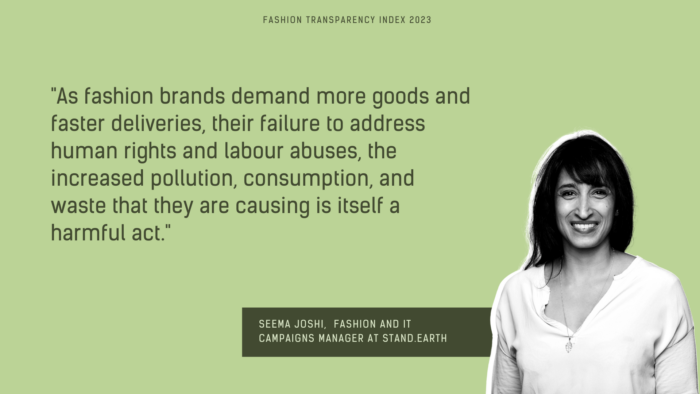
THE FASHION INDUSTRY SHOULD DO NO HARM
Seema Joshi, Fashion and IT Campaigns Director, STAND.EARTH
The fashion industry is facing growing scrutiny to ‘do no harm.’ As a top global emitter, the fashion industry has a responsibility to take proportionate, proactive steps to prevent, identify and address harmful human, environmental and climate impacts originating from its factories and supply chain. Despite this outsized responsibility, according to this year’s Index findings, just 22% of brands disclose the outcomes of steps taken to address environmental issues identified as part of their environmental due diligence and even less (20%) disclose the outcomes of their human rights due diligence.
It’s no coincidence that the places where many fashion brands are offshoring the vast majority of their manufacturing are under-resourced areas in the Global South – where human rights and environmental protections are often poorly enforced, and companies can cheaply export the products and profits back to western countries. As fashion brands demand more goods and faster deliveries, their failure to address human rights and labour abuses, the increased pollution, consumption, and waste that they are causing is itself a harmful act.
Legal action, coupled with emerging regulations in Europe and North America, shows the importance of industry actors being able to prove that they have acted responsibly at all levels of production. The Fashion Revolution’s Transparency Index is an invaluable industry benchmark, which companies can use to show that they have taken the right steps and complied with relevant laws and international standards. This, in return, could protect them against accusations of poor behaviour.
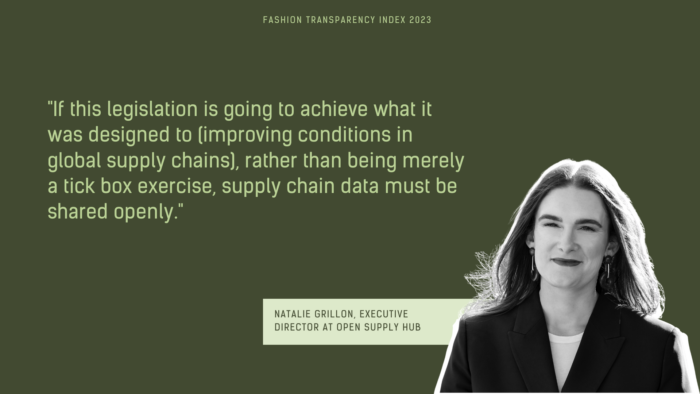
“As the wave of supply chain due diligence and reporting legislation being enacted globally continues to grow, the resulting increase in the volume of apparel brands and retailers choosing to share their supplier data on Open Supply Hub is notable – and encouraging. If this legislation is going to achieve what it was designed to (improving conditions in global supply chains), rather than being merely a tick box exercise, supply chain data must be shared openly, and in a format that enables organisations to work with it practically and efficiently – machine readable, and available for download as an Excel or CSV file. In turn, this will accelerate opportunities for collaboration, as organisations are quickly able to identify shared connections at global production sites. We applaud the brands who have moved ahead of the curve to do just that.”
Natalie Grillon, Executive Director, Open Supply Hub
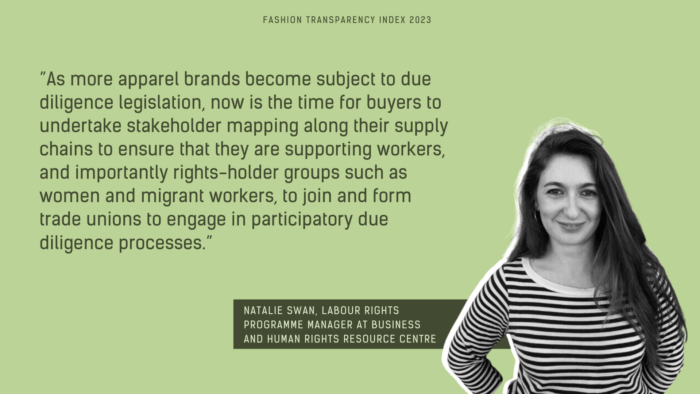
SLOW PROGRESS AND THE TICKING CLOCK OF CHANGE
Urska Trunk, Campaign Manager, Changing Markets Foundation
In the realm of fashion, governments around the world are promising to finally regulate an industry long plagued by unsustainable practices. A wave of approaching legislation should serve as a wake-up call for the fashion industry that prioritising genuine sustainability is no longer optional but necessary.
However, according to this year’s Fashion Transparency Index data, it is as if the fashion industry missed the memo. The progress on transparency and sustainable practices are frustratingly slow, suggesting that many brands might be just paying lip service to green practices and will eventually find themselves left behind in the aftermath of the regulatory storm. In an industry that claims to prioritise ethical and responsible practices, it should be commonplace for brands to openly share information about the types of fibres they use. This transparency serves as the foundation for building trust and fostering responsible consumption. Yet over two thirds (71%) of brands are still tiptoeing around the issue and failing to disclose the percentage or tonnes of fibres used.
While 51% of brands have disclosed sustainable materials strategy, roadmap, or targets, a glaring disparity emerges when compared to the mere 27% of brands actively reporting progress on reducing reliance on virgin fossil fuel-based fibres. This raises a critical question: can a sustainable materials strategy truly exist without addressing the need to reduce both virgin and recycled synthetic materials?
The industry’s selective approach to sustainability that conveniently ignores the link between synthetics and the destructive model of fast fashion, reeks of greenwashing. Despite the European Commission’s EU strategy for sustainable textiles highlighting this connection, the industry continues to turn a blind eye. Shockingly, our research from 2022 revealed that a quarter of major fashion companies increased their reliance on fossil-fuel-derived fibres during the climate emergency. Moreover, our greenwash.com website reveals that brands’ main sustainability materials strategy involves making clothes from plastic bottles; a false solution, as these items are much more likely to end up in landfill than if they were recycled to bottles.
Furthermore, brands are also reluctant to confront overproduction and microplastic pollution. A mere 12% of fashion companies, down from 15% the previous year, disclose the quantity of products produced annually. Most disappointingly, as studies continue to shed light on the devastating environmental and human health impacts of microplastics, less than a quarter of brands (22%, down from 24% last year) disclose what they are doing to minimise the impact of microfibres. This discrepancy between grandiose sustainability claims and sluggish progress on these crucial issues, lays bare the dark side of greenwashing.
In a decade since the tragic Rana Plaza incident, the slow progress in the industry is disheartening. However, upcoming legislation offers hope for reshaping the landscape, increasing clothing sustainability, and holding brands accountable. It will deliver a blow to insidious greenwashing tactics and require substantial evidence for sustainability claims. This will restore trust, empower consumers, and encourage genuine sustainability practices, leaving behind the days of vague claims and empty promises.
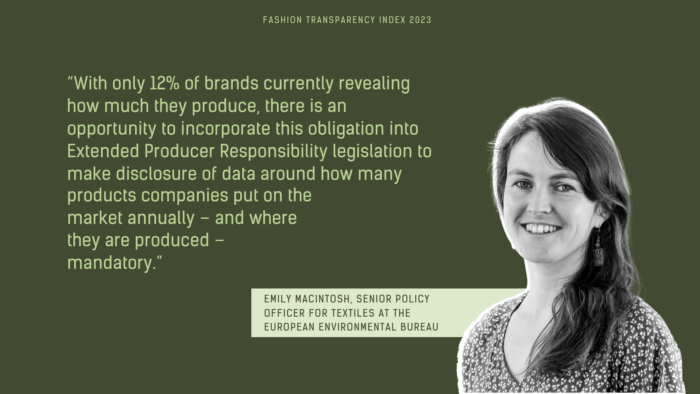
“The fast fashion model that exploits both people and the planet’s finite resources must come to an end. The welfare of people and the planet takes precedence over the textile industry’s pursuit of profits. Textile supply chains show that human rights and environmental consequences cross borders and our responsibility is global. Many voluntary measures and commitments by companies have taken an important step in the right direction, but the reality shows that these are far from enough. We as the EU must lead by example and ensure that the textiles sold in our shops guarantee high environmental and human
rights standards. To achieve this we need binding legislation. That’s why I call for European legislation that guarantees that fashion is not produced at the cost of environmental destruction and human lives. As rapporteur in the Environment Committee for sustainable textiles, I am fighting for this!”
Delara Burkhardt, Member of European Parliament, The Progressive Alliance of Socialists and Democrats
You can read more about upcoming legislation and how brands are responding to this change in the 2023 edition of the Fashion Transparency Index.
Header photo by Wesley Tingey on Unsplash
Overproduction, overconsumption and waste continues to be a growing challenge. It’s one caused by the global fashion industry’s linear ‘take, make, dispose’ model where mostly non-recyclable materials are extracted, made into products, and ultimately down-cycled, sent to landfill, exported through the global secondhand clothing trade or incinerated when no longer used. A crucial way to tackle textile and clothing waste is by investing in efforts to slow down consumption and increase clothing longevity, which would have a significant positive impact on the environment.
A growing number of major brands explain how they’re developing circular solutions that enable textile-to-textile recycling – 38% of brands in 2023, up from 28% in 2022, indicating a big jump from the previous year. Yet, less brands (29%) disclose their annual fibre mix and only 4% of brands publish the percentage of their products designed to enable circularity – which allows for the raw materials in disused clothes to be transformed into raw materials for new clothes.
Given that historically, major brands have released so-called ‘sustainable’ lines representing just a fraction of overall production, the absence of disclosed data on the quantity of a brand’s products that are truly circular does not inspire confidence. In order for these circular solutions to meaningfully contribute to addressing fashion waste, they need to become the norm rather than the exception in the industry. As a first step, greater transparency on brands’ fibre mix is crucial to understanding how to unravel the challenge of circularity.
To better understand the challenges facing the fashion industry, we invited a range of industry stakeholders and activists to provide in-depth analysis of the issues surrounding circular solutions and how governments and brands can adapt their strategies to create meaningful change. Here, you can explore some viewpoints featured in the Fashion Transparency Index 2023.

BUSINESS AS USUAL IS NOT VIABLE
JOSEPHINE PHILIPS, Founder and CEO, SOJO
It’s great to see more of the major fashion brands offering repair services, 26% this year compared with 20% in 2022 – as it not only shows a growing desire from consumers to partake in these practices, but also that brands are taking more accountability for their items post the point of purchase, promoting more circular behaviours.
While this moves the industry in the right direction, it’s important to note that shifting towards circularity needs to happen at every stage of the lifecycle of a product – not just at the point of disposal. For example, when garments are designed with longevity and end-of-life in mind, it entails a different approach towards material sourcing, ways of manufacturing, and end-of-life recycling. Another critical aspect is changing the narrative of how and what we buy. Ultimately, by continuing to pump out the same product volumes, we are not addressing the root-causes of textile waste – overproduction and overconsumption.
Using technology to streamline the tailoring and repair process allows SOJO to provide these services in an easy and accessible way, with online orders and door-to-door delivery of newly fitted or fixed items. The hope is that in the long term this will trickle down to changing consumer behaviour – decreasing consumption volume by helping people love their items for longer.
The British Fashion Council reports an estimated annual cost to brands of £7 billion caused by returns processes with approximately 30% of items bought online returned. With sizing or fit attributed as a leading factor in a customer’s decision to return (93%) and responding to the limited, generic sizing offered by most brands, our services help customers tailor their clothing uniquely to their bodies. In this way, care and customisation of garments happens not only at end-of-life, but also holistically throughout the lifecycle of the garments, supporting the reduction of waste through minimising returns and reverse logistic implications.
These two areas of focus for SOJO show that growing a business is not incompatible with championing a circular fashion industry. In other words, being better for the planet and people does not mean bad business. It’s a very exciting time to be part of the industry, however, scale is critical for creating systemic change. This calls for brands and investors to place bets and take risks to help champion these solutions. Ultimately it’s in their incentive to be part of this change, since it’s clear that the current business-as-usual mentality is not viable – for people, planet, nor profit.
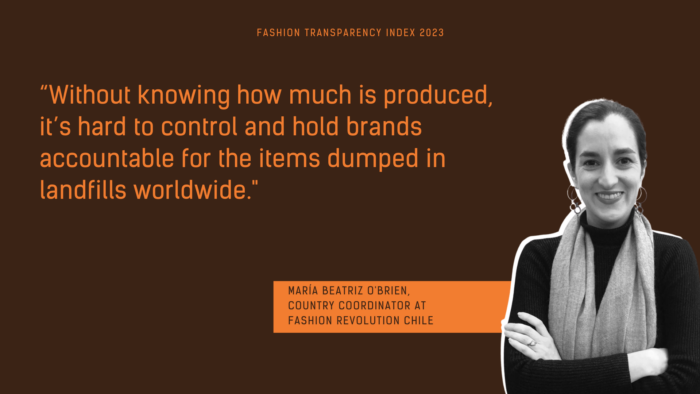
YOUR WASTE, OUR PROBLEM: GLOBAL LANDFILLS WITH LOCAL CONSEQUENCES
MARÍA BEATRIZ O’BRIEN, COUNTRY COORDINATOR, FASHION REVOLUTION CHILE
This viewpoint was featured in the 2022 edition of the Fashion Transparency Index, and so the data has been updated to reflect this year’s findings.
The Atacama Region offers a landscape of unique beauty in earthy and soft colours. The Altiplano Plateau near the Andes Mountains is home to an ancestral and rich textile culture of camelid wool and local iconography.
A world away, the global textile industry based on a fast fashion system continues to accelerate overproduction and overconsumption. Clothing is also massively under-utilised and socially devalued in a race for cheap garments and ever changing trends.
The 1980s marked a new economic model for Chile. Once a strong and proud manufacturing country, the eruption of free market policies made it impossible for the national textile industry to compete with low-cost imports. It encouraged the sale and import of second-hand clothing. Free trade agreements in the 1990s deepened and cemented the model.
The Atacama Desert is the second largest textile landfill in the world. Iquique is the capital of the region and a tax-free port, a point of entry for Chile and neighbouring countries, especially Bolivia. Most bales come in unsorted and the regional government has banned throwing textiles in the local trash. Every year, thousands of tonnes of imported clothes must end up somewhere.
Out of sight is out of mind. Rich countries can export their waste to low-income countries; wealthy neighbourhoods can do the same inside their own territories. Alto Hospicio is a poor community of land seizures and self-built houses. Around 50 landfills are dispersed throughout the area, with little chance of clothing recovery. Picture a scenery of silence; a place where time seems to stand still. Open land where people and nature fade away–a perfect spot to dump and forget.
According to the Fashion Transparency Index 2023, only 12% (30/250 brands) of brands surveyed disclose the quantity of products produced during the annual reporting period, a disappointing drop from last year; In 2022, the data corresponds to 15% (38/250 brands). Without knowing how much is produced, it’s hard to control and hold brands accountable for the items dumped in landfills worldwide.
In Alto Hospicio, clothes leak chemicals into the ground and synthetic microfibres scatter through the air and into the ocean. Water and air are highly polluted, especially because incineration is a common practice. The Index shows very small efforts being made in publishing annual progress on the reduction of synthetic materials deriving from fossil fuels. In 2023, 27% (67.5/250 brands) disclosed this information, up from 24% (59/250 brands) last year.
The Atacama Desert landfill shows the scale of the global waste problem of the fashion industry. For the region, this is an environmental and social disaster. Current national import legislation is lax and has made it impossible for the local industry to resuscitate, suffocated by thousands of tonnes of unwanted clothing from the rest of the world. The region has the right to determine its own textile sovereignty and develop a local economy based on ancestral knowledge and creative design practices, such as the local strong up-cycling movement and sustainable independent designers trying to shape a new national industry.
*Some information included in this viewpoint was provided by Desierto Vestido, a civil society organisation in Iquique raising awareness on the impact on the Atacama Landfill.

WE CANNOT RECYCLE OUR WAY OUT OF OVERPRODUCTION
EMILY MACINTOSH, Senior Policy Officer for Textiles, European Environmental Bureau
The European Parliament recently adopted the EU ‘Textile Strategy’ – a policy plan to bring down the environmental and social impact of Europe’s textile consumption, with a focus on fashion and clothing. And while the approach contains good intentions, it remains to be seen whether its flagship actions on waste prevention will stop the most polluting business practices.
More and more used garments are set to be collected by local authorities when new EU rules requiring separate collection of textiles come into force in 2025. To finance this collection, the EU is working on plans for brands to pay fees that cover the costs of managing their products once they become waste, through so-called Extended Producer Responsibility (EPR) schemes.
But what happens to collected textiles? While we might imagine donated clothing is all reused in Europe, in fact 1.4 million tonnes of used textiles with no EU market value were exported to third countries like Ghana and Kenya in 2020 alone, causing devastating environmental, economic, and human rights’ impacts.
And collecting more garments from 2025 in Europe will mean more and more items entering the global used clothing trade. That’s why money raised through EPR fees must go beyond paying for collection and sorting activities in Europe and support fair remuneration for communities in the Global South who receive exports of clothing castoffs from the EU.
The fees must also be set so they make a meaningful impact on reducing the volume of clothing produced every year because it is overproduction that is the root cause of the climate, environmental and social impacts of clothing consumption. We cannot allow brands to pay to pollute for a minimal fee. In other words, policymakers can ‘eco-modulate’ the fees by rewarding business practices rooted in sufficiency, quality, fairness, and transparency with a lower fee, and penalise those built around throwaway fashion, exploitation, and opaque supply chains with a higher one.
And with only 12% of brands currently revealing how much they produce, there is an opportunity to incorporate this obligation into EPR rules to make disclosure of data around how many products companies put on the market annually – and where they are produced – mandatory.
Because we cannot recycle our way out of overproduction. Overblown green claims on recycling hide the reality that the infrastructure and technology to turn ever-increasing volumes of clothing back into clothing is virtually non-existent, and the recycled fibres that do appear in ‘eco’ ranges make minimal environmental gains.
It’s only by remunerating workers properly at all ends of the supply chain as part of strategies to reduce volumes that we can ease the strain fashion is putting on our planet.
You can read more about overconsumption, waste and circularity in the 2023 edition of the Fashion Transparency Index.
Header image: Tim Mitchell & Lucy Norris from our Loved Clothes Last zine




